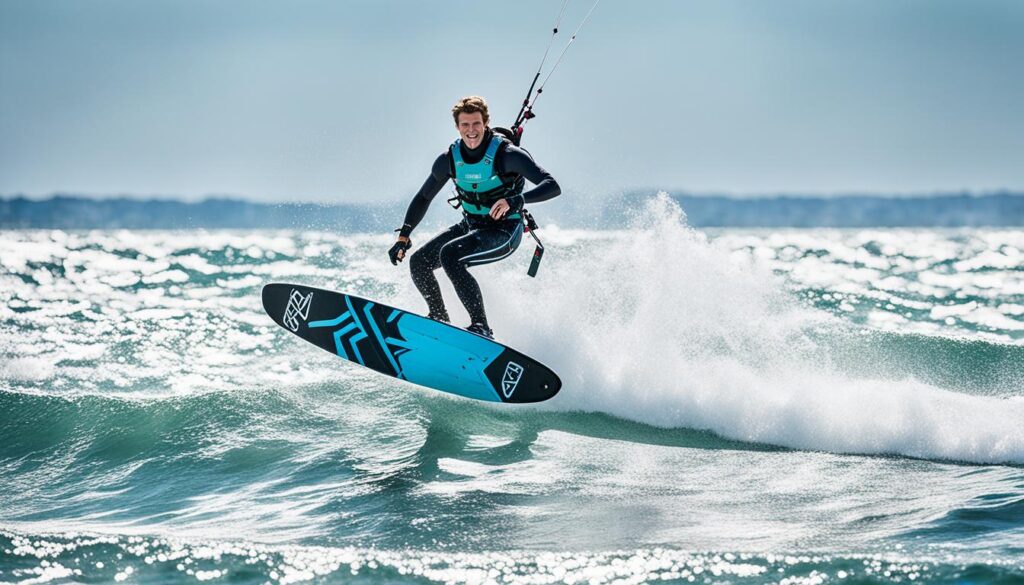Starting your kitesurfing journey means picking the right board. This choice is key to your success and safety on the water. It’s important whether you’re a beginner or an expert.
Finding the right kiteboarding gear can seem hard, but don’t worry. By the end, you’ll know how to pick a board that fits your level and goals. The aim is to find a board that makes you enjoy kitesurfing more and lets you control the wind and waves.
We’ll look at different types of boards and what makes them special. You’ll learn how to find the perfect one for you. Whether you’re new or advanced, the right board is waiting for you. Let’s start your search here.
Understanding Kitesurfing Board Types
Choosing the right kitesurfing board is key to doing well and having fun. There are many types of kiteboards for different conditions and riding styles. Knowing what each board offers helps you pick the best one for you.
Twin-tip boards are very popular and versatile. They have a symmetrical shape. This lets riders move in any direction easily without turning the board.
They are great for freestyle and freeriding. These styles need quick moves and flexibility.
Directional kiteboards are perfect for riding waves. They work like surfboards but with the power of wind. Surf-style boards are a type of directional kiteboard. They help you ride waves better, making them great for wave lovers.
Lightwind boards are made for low wind conditions. They have more surface area for more speed and stability. This makes them perfect for practicing tricks in light winds.
Knowing the differences between twin-tip, directional, and lightwind boards can change your kitesurfing. Whether you’re riding waves or doing tricks, the right board makes a big difference.
Finding the Perfect Board Based on Your Skill Level
Choosing the right kitesurfing board is key at every stage of your journey. For beginners, beginner kiteboard selection means finding a board that is stable and easy to learn on. These boards are wide and have lots of volume to help you stay balanced and feel secure.

When you move to intermediate kiteboarding progression, you need a board that can handle tough conditions and help you improve. Intermediate boards are less bulky and shaped for fast turns and better control. Trying out different types, like directional or hybrid, is a good idea at this stage.
Advanced rider kiteboard features are for those who want top-notch performance and precision. These boards use advanced materials to be light and strong. They also have special shapes and lines that make you go faster and turn quicker in different waves.
Finding the right board for your skill level makes you perform better and have more fun. Each level brings new skills and challenges. So, picking a board that fits your current skills and goals is very important in kiteboarding.
Key Features of Kitesurfing Boards to Consider
Choosing a kitesurfing board is important. The board size and volume match the rider’s weight and the water. A big board helps beginners stay stable and easy to use. Small boards are better for skilled riders because they move faster and turn quicker.
What the board is made of matters too. Boards made from carbon fiber are light and strong. They give riders a smooth ride and more control when going fast.
The flex and rocker profiles change how the board performs. A flexible board moves with the waves for a smooth ride. Stiffer boards are great for fast, bold moves.
The rocker shape of the board is key too. It affects how the board moves. Boards with a deep rocker do well in rough water, making turns smooth and easy.
Choosing the right footstrap and binding options makes a big difference. Adjustable footstraps keep your feet in place. Bindings come in soft or stiff types for different styles of riding. Trying out different setups can make your kitesurfing better fit your style.

Conclusion
Finding the right kitesurfing board is key to a great kiteboarding experience. We looked at different types of boards and how to pick one that fits your skill level. We talked about important things like size, shape, and materials to help you choose.
Every rider is different, so think about what you need most. Do you want to be fast, stable, or agile? Knowing what you want makes picking a board fun and easy. You now have the knowledge and confidence to find a board that’s right for you.
Your kiteboarding adventure is ready to start! With this article’s tips, you can find a board that’s perfect for you. Get ready for an amazing kiteboarding experience. Start this exciting sport and let your spirit fly high on the water.
